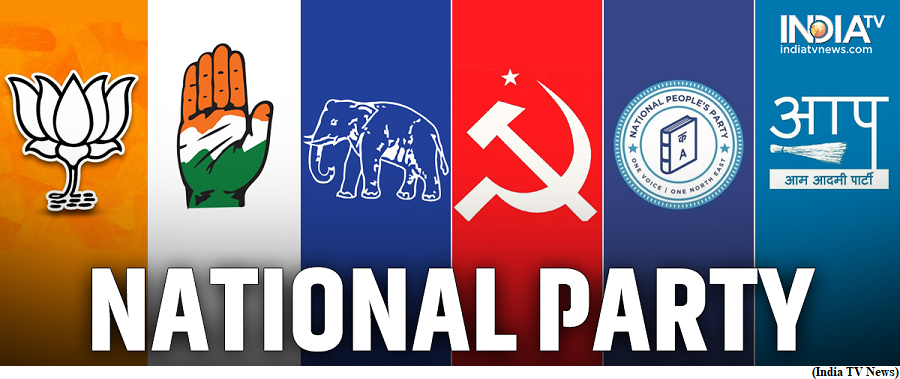The rules for recognition as a national party (GS Paper 2, Polity and Governance)

Why in news?
- Ahead of the upcoming Karnataka Assembly elections, the Arvind Kejriwal-led Aam Aadmi Party (AAP) was accorded the status of a national party by the Election Commission of India.
- Meanwhile, the Trinamool Congress (TMC), the Communist Party of India (CPI), and the Nationalist Congress Party (NCP) lost their national party status.
- The EC also revoked the recognition of some parties as State parties.
How does a party get recognised as a national party?
- The Election Commission reviews the poll performance of recognised parties after every State Assembly election or general election to the Lok Sabha.
- The rules for recognition as a national party are specified by the Commission in para 6B of the Election Symbols (Reservation and Allotment) Order, 1968.
- A party becomes eligible to be accorded national status if it manages to fulfil one of the following conditions:
- if it is recognised as a State party in at least four States,
- if it secures 6% of the total votes polled in four States in the last Lok Sabha or Assembly elections, and in addition, gets four of its members elected to the Lok Sabha, or
- if it wins 2% of seats in the Lok Sabha from at least three States.
Additional pass over:
- Besides this, the Symbols Order of 1968 was amended in 2016 to give parties one additional “pass over”.
- As per this amendment, deemed to have been in force since January 1, 2014, if a national or State party fails to fulfil the eligibility criteria in the next general elections (March 2014 Lok Sabha polls in this case) or the Assembly election after the election in which it received recognition, it will continue to be recognised as a national or State party, meaning it will not be stripped of its status.
- However, whether it will continue to be recognised after any subsequent election would again have to be determined by the eligibility criteria.
Recent status granted & revoked:
AAP:
- The AAP gained national status, as it was recognised as a State party in four States — Delhi, Punjab, Goa, and Gujarat.
- Its application with the EC was pending since the Gujarat election results, but a Karnataka High Court order asked the poll body to decide on the party’s status before the State Assembly elections were notified.
Trinamool Congress:
- The Trinamool Congress, which lost its national status, had gained it in 2016 by virtue of the “pass over” amendment to the Symbols Act.
- It was a State party in three States; West Bengal, Tripura, and Manipur but it did not meet eligibility conditions to remain a State party in Arunachal Pradesh in the 2014 General and State elections. However, the Commission did not revoke its State party status, in line with the amendment.
- In the EC’s most recent review, the party did not manage to remain a State party in the required four States, losing its status in Manipur and Arunachal Pradesh, while continuing to hold recognition in West Bengal, Tripura, and Meghalaya.
NCP:
- Meanwhile, the NCP lost its recognition in three States (Goa, Manipur, and Meghalaya) where it did not secure enough assembly votes between 2017 and 2018. It is currently a State party in only two States — Maharashtra and Nagaland.
CPI:
- Lastly, the CPI, which was accorded national status in 1989, also retained its status despite its performance in the 2014 Lok Sabha election, courtesy the amendment to the Symbols Act.
- While the EC held off on its revocation of the party’s national status during the pandemic, it was withdrawn.
What are the criteria to be recognised as a State party?
- For recognition as a State party, it has to secure at least 6% of the valid votes polled and two seats in Assembly polls or one in Lok Sabha polls.
- There are three other alternatives for eligibility:
- at General Elections or Legislative Assembly elections, the party has to win 3% of the seats in the legislative assembly of the State (subject to a minimum of 3 seats),
- at a Lok Sabha General Elections, the party has to win one Lok Sabha seat for every 25 Lok Sabha seats allotted for the State, or
- at a General Election to the Lok Sabha or the Legislative Assembly, the party has to poll 8% of votes in a State.
- Besides, the changes to the state recognitions of the TMC, the NCP, and the CPI, the ECI also revoked State party status granted to the Rashtriya Lok Dal in Uttar Pradesh, the Bharat Rashtra Samithi in Andhra Pradesh, the People’s Democratic Alliance in Manipur, the Pattali Makkal Katchi in Puducherry, the Revolutionary Socialist Party in West Bengal and the Mizoram People’s Conference in Mizoram.
- The Tipra Motha in Tripura, the Lok Janshakti Party (Ram Vilas) in Nagaland and the Voice of the People Party in Meghalaya were granted “recognised State political party” status.
What are the benefits of recognition as national and State parties?
- A recognised political party enjoys privileges such as a reserved party symbol, free broadcast time on State-run television and radio, consultation in the setting of election dates, and giving input in setting electoral rules and regulations.
- Candidates put up by registered but unrecognised political parties are allotted election symbols by the Returning Officers of the constituencies after the last date for withdrawal of candidature as per availability. Thus, the party cannot use a single poll symbol across the country.


